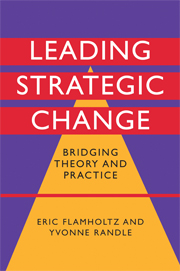Book contents
- Frontmatter
- Contents
- List of exhibits
- Preface
- Acknowledgments
- Part I An integrative framework for leading strategic and organizational change
- Part II Leading strategic change in actual organizations
- 4 Leading strategic and organizational change at Countrywide Financial Corporation
- 5 Leading change at Starbucks Coffee Company
- 6 Strategic marketing through HR interventions: a case study of Indian Oil Corporation
- 7 The evolution of Stan Tashman and Associates
- 8 Leading strategic and organizational change at IndyMac Bank
- 9 Leading strategic and organizational change at Infogix
- 10 Leading strategic and organizational change: the transformation of structure at Pardee Homes
- 11 Leading strategic and organizational change at Tata Steel: the role of culture
- 12 Leading strategic and organizational change at Westfield: transformation to a global enterprise
- Part III Leading strategic change: lessons learned from practice
- Appendix: References for further reading on leading change
- Index
10 - Leading strategic and organizational change: the transformation of structure at Pardee Homes
from Part II - Leading strategic change in actual organizations
Published online by Cambridge University Press: 22 September 2009
- Frontmatter
- Contents
- List of exhibits
- Preface
- Acknowledgments
- Part I An integrative framework for leading strategic and organizational change
- Part II Leading strategic change in actual organizations
- 4 Leading strategic and organizational change at Countrywide Financial Corporation
- 5 Leading change at Starbucks Coffee Company
- 6 Strategic marketing through HR interventions: a case study of Indian Oil Corporation
- 7 The evolution of Stan Tashman and Associates
- 8 Leading strategic and organizational change at IndyMac Bank
- 9 Leading strategic and organizational change at Infogix
- 10 Leading strategic and organizational change: the transformation of structure at Pardee Homes
- 11 Leading strategic and organizational change at Tata Steel: the role of culture
- 12 Leading strategic and organizational change at Westfield: transformation to a global enterprise
- Part III Leading strategic change: lessons learned from practice
- Appendix: References for further reading on leading change
- Index
Summary
Introduction
This chapter examines the transformation to professional management at Pardee Homes. Its particular emphasis is upon the transition from one type of organizational structure (functional) to another (matrix) as part of the overall transformation.
The focus upon structure is of particular significance, because the experience of Pardee Homes highlights the critical but often neglected role of structure as a key variable in determining organizational growth and success. Typically, the academic literature on organizational structure treats it in a descriptive way rather than as a driver or limitation of organizational success.
Company description and history
Pardee Homes is a multi-regional real estate development company with a focus on developing master-planned communities and building single-family and multi-family homes. It is headquartered in Los Angeles, and has regional offices in southern California (Corona, Irvine, San Diego, and Valencia), northern California (Pleasanton and Sacramento), and Nevada (Las Vegas). In 2006 Pardee Homes achieved revenues of about $2.0 billion from the construction and sale of more than 3,000 units (homes) by approximately 700 employees.
The company was founded in 1921 by George Pardee, Sr., as a builder of custom homes. In 1969 the company was acquired by Weyerhaeuser, a global leader in the forest products industry, and became the largest subsidiary of Weyerhaeuser Real Estate Company (WRECO).
In 2003 Pardee Homes celebrated fifty years of homebuilding in Nevada, and in 2004 it celebrated fifty years of building in San Diego.
- Type
- Chapter
- Information
- Leading Strategic ChangeBridging Theory and Practice, pp. 168 - 187Publisher: Cambridge University PressPrint publication year: 2008



